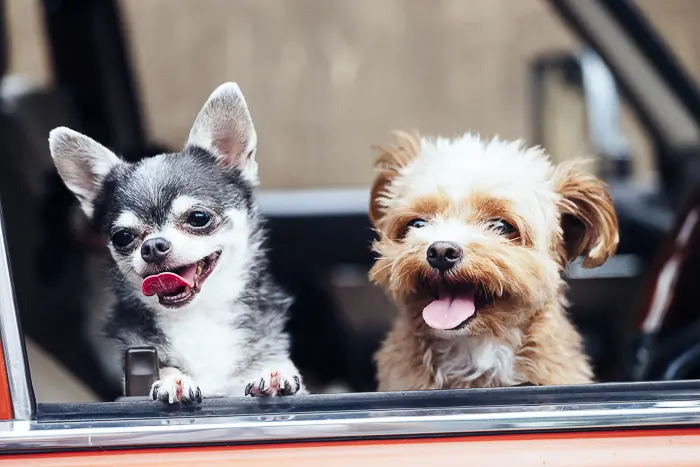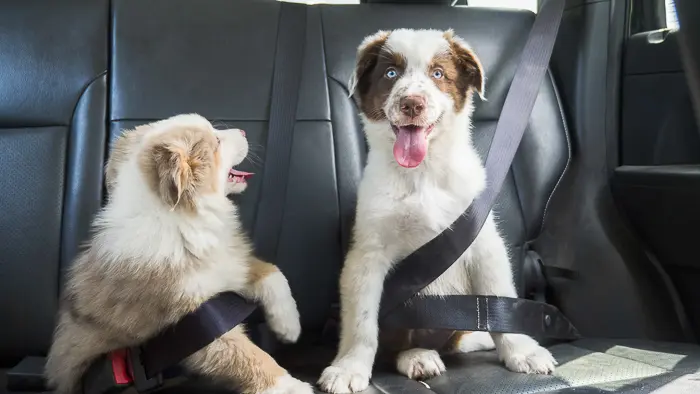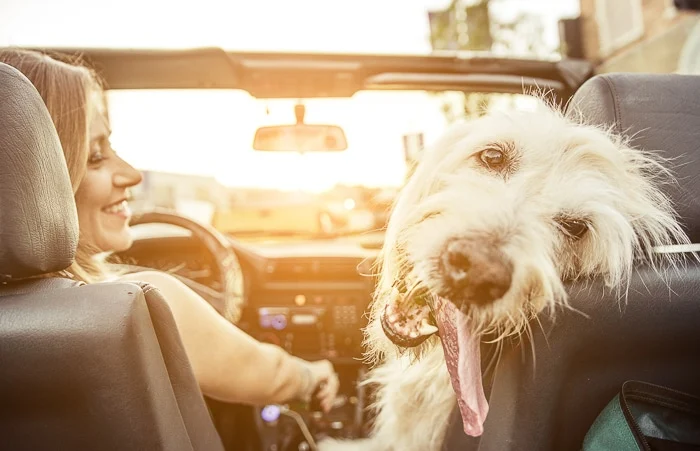Dogs can be amazing companions – keeping you company at home and while traveling. Every dog has their own personality and behaviors, and these can change while traveling, especially in the car. Many dogs pant in the car. But Why do dogs pant in the car?
What is Panting?
Panting is open-mouthed respiration in a canine.
What panting looks like: Your dog’s tongue probably hangs out of their mouth and their breathing is faster and deeper than when not panting.
Many times the dog will slobber while panting and many times the panting comes with airy sounds of your dog taking big breaths of air in and out.
Why Do Dogs Pant?
Dogs pant for many reasons. The reasoning may be good or bad, pain or excited, or could be anything from hot or overheated to anxious dog problems.
Open-mouthed respiration is a normal canine behavior.
But let me explain a few of the most common reasons that Why do dogs pant in the car?
Panting as a Way to Exchange Oxygen.
Dogs and puppies use panting just like normal breathing in the sense that it also allows oxygen into the dog’s bloodstream and helps to remove carbon dioxide during the oxygen-carbon dioxide exchange in the capillaries in the lungs.
Panting is breathing, but more rapidly and deeply – allowing even more oxygen and carbon dioxide to be exchanged in less time.
Panting Lowers Body Temperature.
It’s importance is to lower the body’s temperature. And Why do dogs pant in the car?
Panting is also a cooling mechanism for the dog.
Panting is necessary because dogs do not have an effective or efficient system of sweating like most mammals do, including humans.
Dogs lack the number of sweat glands that would be necessary to help reduce excess heat and cool their bodies off effectively.
Dogs do have sweat glands in a few places, such as the bottom of their feet.
Instead, dogs cool their bodies using the evaporation of moisture from their mouths and tongue during panting, and by exchanging the hot air of their lungs with cooler external air.
Panting allows your dog to release heat in the form of hot breath, and exchange it for cooler air from the environment (as long as that environmental air the dog is breathing in is LESS than 201)
When a dog becomes hot, let’s say from exercising, they will pant to try and cool their bodies down, much like the way humans breathe heavily when doing aerobic exercise!
The hotter a dog becomes, the more intense the panting becomes, deeper and faster pants.
Why do dogs pant in the car? Dogs will start to pant when they get even a little bit warm and will pant harder and faster the warmer their bodies get, no matter the reason why they were originally panting.
For short-faced dogs, like bulldogs, Boston terriers, boxers, and pugs, they can become hotter much quicker because of their face shape, also known as being brachiocephalic – or having a really cute smushy-face with all those adorable wrinkles!
Panting may also means that they are thirsty.
Panting out of Excitement or Happiness:
Panting may simply be a sign of happiness in your dog. Your dog may pant when you come home from work because they are excited to see you, for example.
Your dog’s tail will usually be wagging in a happy way. Your dog’s body and facial features will be relaxed with their eyes bright and happy.
Once the situation calms down, so should the panting.
The panting will slow down and eventually cease.
Continued mild panting with an open mouth and bright eyes is normal in a relaxed, content dog.
In fact, many people consider this to be their dog’s “smile”.

Panting Due to Stress:
Panting may have nothing to do with happiness or body temperature.
In fact, it may be out of a different type of excitement – and not the fun kind – the stressful type of excitement.
Why do dogs pant in the car? Many dogs will pant when they are excited by fear, anxiety, or stress.
Fireworks, car rides, separation anxiety (cage or kennel anxiety for example), vet visits, moving or moving boxes, guests in the home, vacuum cleaners, and other stressful events are very common reasons why dogs pant due to stress.
Look at your dog’s body language to help you determine if your dog is showing signs of distress.
Some of these distressed body language patterns include but are not limited to:
- shaking or shivering,
- hiding or crouching,
- ears down,
- tail down or tucked between legs,
- drooling accompanying the panting,
- no eye contact,
- head turned away,
- etc.
Remove your dog from the stressful or scary situation as soon as possible and you will likely see the panting dissipate.
Panting From Pain or Discomfort:
Similar to the point above of panting out of stress, your dog will likely pant out of pain or discomfort – it is a very real and common reason why dogs pant.
In fact, it is one of the many signs that us vets use to help us determine if a dog is hurting!
Once your dog reaches a certain pain or discomfort level, they will most likely start to pant. The panting can become harder and faster the more intense the pain becomes or the longer that the discomfort is there.
Also, panting can be part of a dog’s allergic reaction from an ingested (or eaten) or topical (on the skin) substance that your dog is allergic too.
Where Do Dogs Pant?

Can Panting Be A Negative Sign? why do dogs pant in the car?
Panting is normal. However, excessive panting is not normal but somewhat common unfortunately in the vet clinic’s emergency room.
That’s why it’s so incredibly important to check in with your veterinarian to know what’s really going on with your dog if you have concerns over their panting.
If your pup’s panting is making a raspy or wheezy sound, they may be having difficulty in breathing.
So if your dog’s panting seems excessive compared to normal you MUST contact your local vet immediately to discuss the details – they may need to be seen immediately.
If your dog is lying on their side panting and doesn’t want to get up or can’t catch his breath or is not responding to things that they normally would respond to, then they may be experiencing a medical emergency.
Panting Due to Medical Problems:
Here are just a few common medical problems associated with panting dogs:
- Dogs with an apparently high fever may pant to help lower their body temperature through the same process as is explained above.
- Stomach bloat may cause your dog to pant, due to extreme pain and the decreased lung volume (because the stomach has expanded and therefore there is less rom inside the dog for the lungs to expand because of the over-inflated stomach), and sometimes in preparation for vomiting. This is an emergency and your pet should be evaluated immediately if they are vomiting or dry heaving and panting.
- Dogs with certain metabolic syndromes and diseases such as Cushing’s disease, which is a condition caused by excessive production of the stress hormone cortisol, can cause excessive panting. Remember the whole bit above about stress and panting??? M-hmmmm!!!! Other metabolic issues can be seen with the same sign of panting.
- Motion sickness, which mostly affects puppies, but sometimes dogs never grow out of it. Medications and training can help with motion sickness.
Panting Versus Labored Breathing:
Panting and labored breathing are not the same thing.
Labored breathing is characterized by strained or laborious respiration or attempts at heavy breathing in and/or out.
This may be accompanied by sounds of distress like crying or whining, wheezing, or whistles from the nostrils or windpipe due to blockage either by a foreign body or from inflammation of the respiratory tract.
If at any time you see that panting is extremely intense or has been going on for a very long period of time and cannot be explained, you should get your dog to the nearest veterinarian immediately.
It’s always best to play it safe and let your vet check things out. When in doubt, take your dog to the veterinarian for medical attention.
At the very least- contact your vet to discuss the issue and your concerns!
Why Do Dogs Pant in the Car?
Why does your pup pant so much in the car?
Car rides can make you canine companion feel so many different ways: happy, nervous, excited, anxious, scared, and expect mixed emotions.
If your pet is not used to going out with you, or it’s been awhile since they have, or you haven’t trained your pet to control themselves from unknown or strange things with socializing when they were young, then they will possibly experience anxiety and excitement, which can both lead to undesirable behaviors to your dog, including panting.
Newly diagnosed or undiagnosed medical conditions can also be a reason why your dog may now feel more fear or anxiousness in the car. For example, if your dog has become deaf or blind and now gets anxious during car trips.
Cars are big and hard and noisy and sometimes they smell odd.
There’s a lot of new and strange things whizzing by the windows.
For many dogs, riding in the car takes guts!
Road trips are even worse when car rides always end in unpleasant experiences, such as a vet visit for vaccines or surgery.
If your dog never rides in the car except for when you take him to the vet (or another place they have a distaste for), they’ll start putting two and two together and realize cars equal fearful situations.
Other reasons why your dog pants in the car besides being happy, excited, stressed, or scared may be because they are hot, thirsty, or are uncomfortable and in pain, or because they are getting motion or car sickness.

Preventing Excessive Panting in the Car:
- Check The Temperature inside your car– before going out for a walk or leaving your dog inside your car, you should check the temperature and the weather. Do NOT leave your dog inside a car – as they can overheat quickly which can lead to serious medical problems and death. Make sure the temperature inside and outside the car is good for your dog before taking them on car rides.
- Keep Your Dog Hydrated – always provide clean and fresh water for your dog so it won’t get dehydrated.
- Decrease Car Anxiety – you can either train your dog to calm down from new or strange things or let your pet take anxiety treatment BEFORE going out for a car trip. Not allowing them to become anxious is KEY is the perfect way to keep them happy and prevent dog car anxiety!
- Give Your Dog Love Along the Way– comfort hugs, kisses, and other forms of love between you and your canine (while not driving of course!) is a perfect solution for your pet whenever it feels fear, anxiety, excitement and etc. This allows them to calm down and focus on you.
Why Do Dogs Pant in the Car? Understanding Your Pup’s Behavior
Dogs are beloved travel companions, but many owners notice something concerning during car rides: their dog starts panting heavily.
Why do dogs pant in the car? While panting is a normal behavior for dogs, excessive or unusual panting in a vehicle can signal several underlying causes that deserve attention.
Understanding Normal Dog Panting
Dogs pant to regulate their body temperature. Unlike humans, dogs don’t sweat through their skin. Instead, they release heat primarily through their mouths and paw pads.
So, when a dog is hot, anxious, or excited, panting becomes a natural response. However, understanding why do dogs pant in the car requires digging deeper into emotional and environmental triggers.
Car Anxiety and Motion Sickness
One of the most common reasons dogs pant during car rides is anxiety. Dogs may associate car travel with stressful events, like vet visits. The motion, noise, and unfamiliar smells can all contribute to discomfort. If your dog shows signs like pacing, whining, or trembling in addition to panting, it’s likely due to fear or motion sickness.
Addressing this form of anxiety may involve gradual desensitization, comforting scents like lavender, or in more severe cases, consulting a vet for calming treatments. Knowing why do dogs pant in the car can help prevent unnecessary stress for both dog and owner.
Overheating and Temperature Control
Overheating is another major factor. Even when it doesn’t feel hot to us, cars can warm up quickly, especially under direct sunlight. A dog panting in a warm vehicle may be trying to cool down.
Always check your car’s temperature before letting your dog inside. Never leave your pet unattended in a parked vehicle, even with the windows cracked—it can become dangerously hot in minutes.
So, why do dogs pant in the car when temperatures seem mild? Sometimes it’s the combination of humidity, excitement, and limited airflow. Proper ventilation and shaded windows can help manage this issue.
Excitement or Anticipation
Some dogs simply love car rides! The excitement of a new adventure or destination can lead to energetic panting. While this isn’t necessarily harmful, it’s important to differentiate between happy anticipation and distress.
Health Issues That May Cause Panting
If your dog pants heavily in the car regardless of the temperature or mood, consider underlying health problems. Respiratory issues, heart conditions, or obesity can all contribute. Consulting your veterinarian is crucial to rule out medical causes if your dog pants excessively during every car trip.
Tips to Help Your Dog Travel Comfortably
- Keep the car cool and well-ventilated
- Use a pet safety seat or harness to reduce anxiety
- Bring water for hydration
- Practice short, pleasant trips to build positive associations
Summery
Why do dogs pant in the car? The answer could lie in temperature, anxiety, excitement, or health. Understanding your dog’s body language and environmental triggers is the first step in helping them feel safer and more relaxed on the road.

